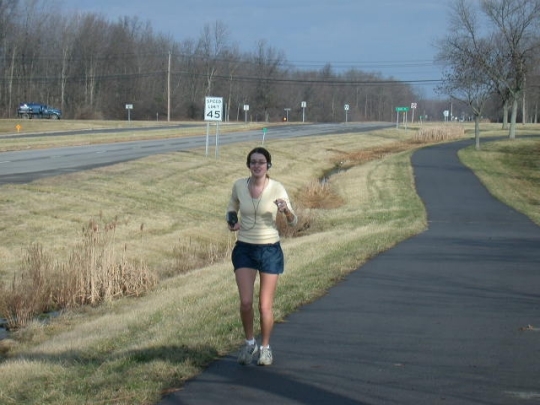 The most common place to run, and usually the most convenient, is the road. Most people can just step outside of their homes, hit the road, and be off on an infinite number of routes.
The most common place to run, and usually the most convenient, is the road. Most people can just step outside of their homes, hit the road, and be off on an infinite number of routes.The three main types of routes that runners use are loops, out-and-backs, and point-topoints. Loops involve running a big circuit around your starting and finishing point. Outand-backs are where you head out for a set time or distance, usually with just a few turns, turn around at halfway, and then retrace your steps home. With a point-to-point route, you start at one place and end at another. This type of route usually requires someone to drop you off or meet you at one end.
Roads are good places to run because you’re usually familiar with the ones in your neighborhood. A lot of times, running in known territory makes a run go by more quickly mentally. The firm footing of most asphalt road surfaces means that you don’t have to worry about turning an ankle, as you might if you’re running on grass or rugged trails. Races are almost always going to be held on roads, so by training on them, you’ll be used to that surface if you decide that you want to race. Roads are also a good choice because you can drive courses in your car before running on them so that you know what the footing, terrain, and distance will be like.
Of course, that firm footing comes with a price. Humans didn’t evolve to run for hours at a time on asphalt. If you’re new to running, you’re probably going to be sore enough for the first couple of months. Pounding away on a hard surface will probably only make that soreness worse. That’s why it’s so important to have a good pair of running shoes if you’re going to be taking it to the streets.
Another thing to be mindful of on the roads is the slant. Most roads tilt slightly from the center. If you’re running against traffic, your left leg will be operating as if it’s a bit longer than your right one. Also, your right foot will turn in a bit more when you land because you’re on an uneven surface. Both of these stresses to your legs can lead to injury, so try to avoid roads that have a really obvious slant to them. Run toward the middle of the road if you can safely do so. And let’s not forget our good friend, the automobile.
Regardless of what traffic laws say about sharing the roads, cars rule. Thanks to the millions of runners out there, things are definitely better than they were 25 years ago, when runners on the roads were looked upon as freaks. Today, at least, most drivers are used to seeing runners on a regular basis, but that doesn’t mean that they’re going to cut you much slack. The solution? Do your best to stay off of heavily traveled roads. Even in the busiest cities, you can usually find a mile or two of relatively open road. In addition to being safer, less-traveled roads are just a lot more fun to run on because you can relax a bit more and feel a bit more like you’re getting away from it all.
Although they’re not really roads, I’ll include bike paths in this section also because they’re usually made of asphalt. Don’t let the name fool you. Runners know that “bike path” is usually code for “nice place to run where you don’t have to worry about cars.” In Boston, for example, there’s an asphalt path along both sides of the Charles River for about nine miles in each direction. It’s where most of Boston’s runners congregate to get in some hassle-free miles away from busy streets. Most metropolitan areas have at least a few miles of bike paths. Seek them out.

No comments:
Post a Comment